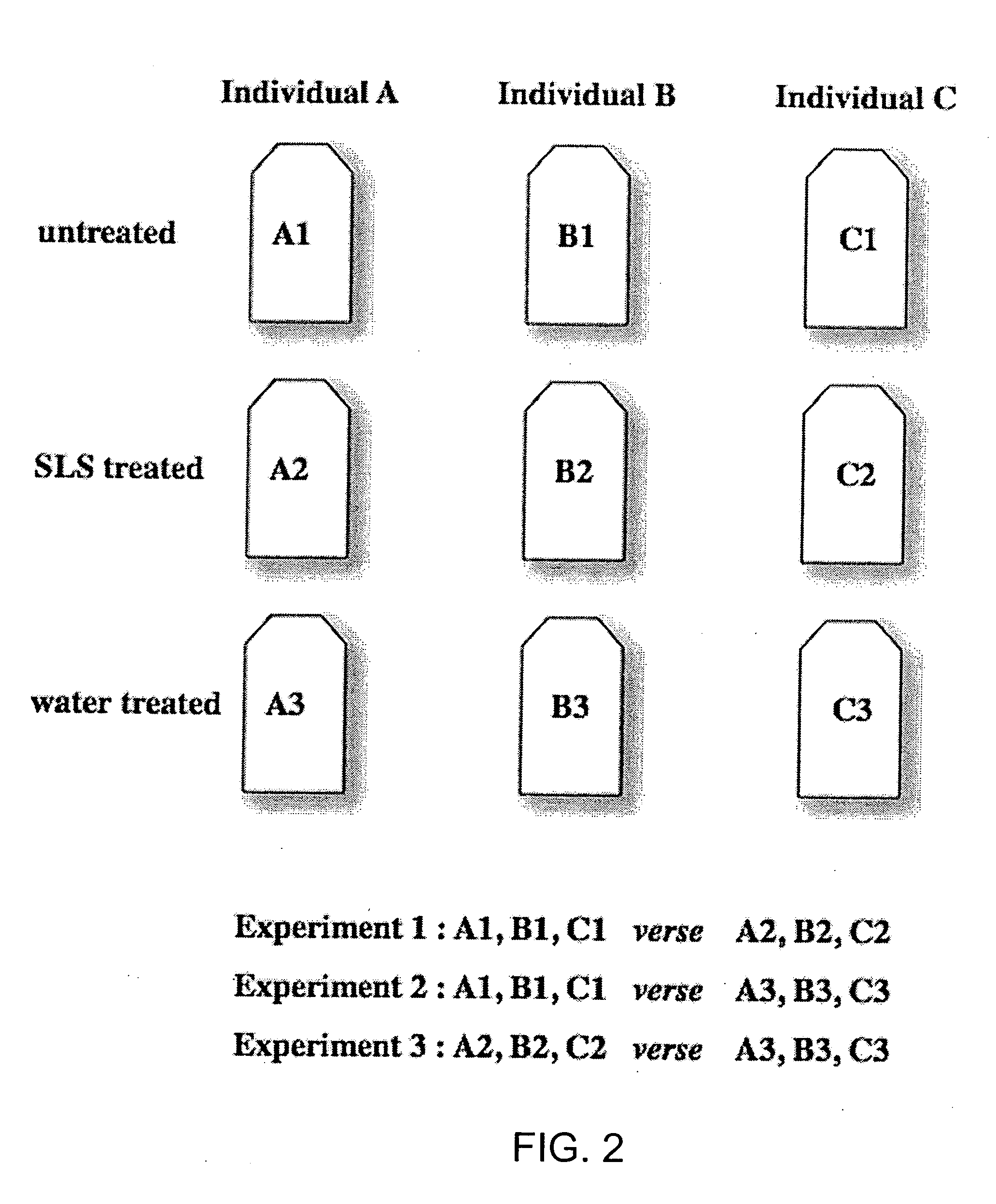Tape stripping methods for analysis of skin disease and pathological skin state
a skin disease and pathological technology, applied in the field of non-invasive diagnostic methods, can solve problems such as revealing cutaneous irritation
- Summary
- Abstract
- Description
- Claims
- Application Information
AI Technical Summary
Benefits of technology
Problems solved by technology
Method used
Image
Examples
example 1
[0145] Identification of Superior Tape Characteristics for Isolating Nucleic Acid Acids from Skin Samples
[0146] The objective of this experiment was to compare adhesive films of differing rigidity for the ability to remove epidermis and associated total RNA from of surface of the skin.
[0147] The experimental protocol described here is designed to test the hypothesis that rigid tapes will remove more epidermis (and hence recover more RNA) than an equivalent adhesive on a less rigid support.
TABLE 5Product codes for adhesive tape test samples.ProductPropertyCodeDescriptionMeasured413-201-13.0 mil clear PET (polyester film) / 413-Stiff backing166-A (approx. 2.9 mil / 2.0 mil ARMS)Adhesive identical to sample 413-92-1413-92-13.0 mil PU (polyurethane film) / 413-92-AFlexible backing(approx. 2.9 mil / 2.0 mil ARMS releaseliner)
[0148] Procedure: Two main sites on the upper back with minimal hair were chosen for the tape stripping. Each site was about 40 mm×40 mm in size so as to allow three non...
example 2
[0156] The Use of RT-PCR and DNA Microarrays to Characterize RNA Recovered by Non-Invasive Tape-Harvesting of Normal and Inflamed Skin
[0157] This example illustrates a non-invasive approach for recovering messenger RNA from the surface of skin via a simple tape stripping procedure that permits a direct quantitative and qualitative assessment of pathologic and physiologic biomarkers. Tape-harvested RNA is shown to be comparable in quality and utility to RNA recovered by biopsy. Using SLS irritation as a model system, the utility of assaying changes in IL-1β and IL-8 mRNA has been tested as an indication of irritant skin reactions and show that both sampling methods allow the recovery of RNA, the analysis of which reveals cutaneous irritation. Data is presented that biopsy and tape-harvested RNA are likely derived from different cell populations and that tape harvesting is an efficient method for sampling the epidermis and identifying select differentially regulated epidermal biomark...
example 3
[0211] Non-Invasive Isolation of Epidermal RNA from Psoriatic Patients Using Tape Stripping Method Provided herein
[0212] This example illustrates the isolation and detection of nucleic acids from psoriatic lesions and the identification of genes whose expression is associated with psoriatic lesions. This example summarizes the results of tape harvesting lesional and non-lesional skin in 24 psoriatic patients in various treatment stages. The goal of this investigational work was to determine if DermTech's Epidermal Genetic Information Retrieval Technology (EGIR), which is a tape disk used with a synthetic rubber-based adhesive (Adhesive Research, Glen Rock, Pa.) on a polyurethane film (Product No. 90068), could successfully recover RNA from the surface of lesional and non-involved skin from psoriatic patients; and to semi-quantitate recovered RNA for specific mRNA molecules known to be elevated in psoriatic lesions. The data generated from these patients demonstrates that RNA can be...
PUM
| Property | Measurement | Unit |
|---|---|---|
| peak force | aaaaa | aaaaa |
| peak force | aaaaa | aaaaa |
| thickness | aaaaa | aaaaa |
Abstract
Description
Claims
Application Information
 Login to View More
Login to View More - R&D
- Intellectual Property
- Life Sciences
- Materials
- Tech Scout
- Unparalleled Data Quality
- Higher Quality Content
- 60% Fewer Hallucinations
Browse by: Latest US Patents, China's latest patents, Technical Efficacy Thesaurus, Application Domain, Technology Topic, Popular Technical Reports.
© 2025 PatSnap. All rights reserved.Legal|Privacy policy|Modern Slavery Act Transparency Statement|Sitemap|About US| Contact US: help@patsnap.com



